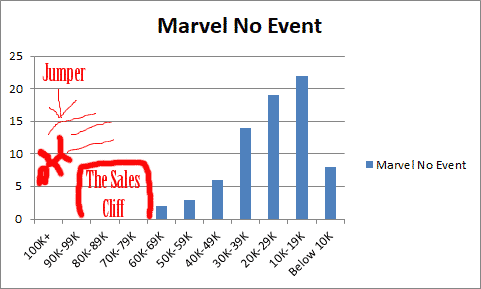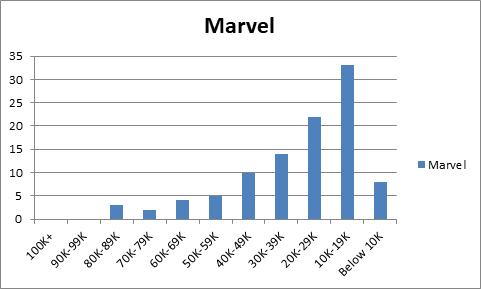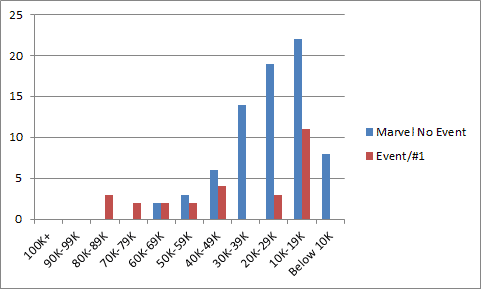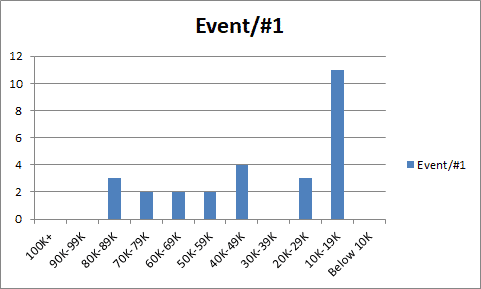Now it’s time for a look at Marvel’s sales distribution charts for August.
Standard disclaimers: The numbers are based on the Diamond sales charts as estimated by the very reliable John Jackson Miller. These charts are pretty accurate for U.S. Direct Market sales with the following caveats: 1) you can add ~10% for UK sales, which are not reflected in these charts; 2) everyone’s best guess is you can add ~10% for digital sale – while some titles do sell significantly better in digital (*cough* Ms. Marvel *cough*), that’s the average rule of thumb; 3) it’s not going to include reorders from subsequent months, although reorders will show up in subsequent months if they’re high enough. So if you’re a monster seller in Southampton and the it took the US audience 3 weeks to reorder, it’s probably not going to be reflected here.
What’s a sales band? It’s another way to have a higher level view of the market. The general idea is to divide the market into bands of 10K copies sold and see how many issues are in each band. How many issues sold between 90-99K copies, 80-89K copies, etc. etc. In very broad terms, the market is healthier when there are several titles selling in the 70K-100K+ range because titles that move a lot of copies give the retailers some margin of error on their ordering. When you see titles selling in the 20-29K band and especially below, there’s a pretty good chance a lot of retailers aren’t ordering those titles for the shelf (pull box/pre-order only) or minimal shelf copies at best.
Marvel is not in a good trend. Not. At. All.
The high seller for the month was Secret Empire #10 at just over 86K. That must’ve had increased orders for anticipated rubbernecking, because that series bottomed out with an estimated 77K for issue #9. A Marvel big deal Event series dropping below 80K? Not something you’d have expected to see before this year.
These big deal Generations specials? Around 85.7K for the Wolverine one. 76.4 for the Thor one. 61.3K for the Hulk one and falling off from there.
These are not the kind of numbers you expect for a Marvel event, especially not when there’s a #1 on those specials. However, not everyone on the fan or retailer side of the business necessarily buys into Marvel’s hype on Generations.
Star Wars is the highest selling ongoing/non-Event/non first issue series. A two issue month, hitting at ~66.6K and ~66K. The highest selling ongoing title set in the Marvel Universe is Amazing Spider-Man #31 at ~54.1K.
As is the custom, let’s break this out into ongoing titles vs. the Event mini’s (anything with Secret Empire or Venomverse in the tile) and #1s with all their variant covers.
The vast majority of the Event/#1s in the 10K-19K bracket are $1 Kirby anniversary specials, so we should take that with a grain of salt. However, look at the no event chart and you’ll see that Marvel’s sweet spot appears to be issues getting ordered in at under 20K. That’s an awful lot of comics with minimal to no shelf stocking. If an ongoing comic is selling 40K at Marvel, it’s a hit. Would 40K even have been considered mid-list a couple years ago?
I’ve got a term it may be time to start using for when you get over that 60K sales bracket: The Sales Cliff
Because when you start getting over 66K, the sales jump right off a cliff. There’s nothing going on above it for ongoing titles and, let’s be honest – when an event book or a #1 with Marvel’s usual assortment of sales incentives and variant covers is listed above it, you can’t be sure there are more than 60-69K readers/buyers for those issues, even if that’s how they’re ordered. We’d need a sellthrough tracking system like Bookscan to know what the real audience for those comics is. I’ll talk about that Cliff a bit more when it’s time to compare August for DC and Marvel.
Is there good news for Marvel’s single issue sales? So far Darth Vader is holding up fairly well, relative to the rest of the line.
Marvel’s making their marketshare by pumping out lots of issues of comics that just don’t sell very well as single issues.
What the Marvel boosters are going to be chanting is “wait for the lenticulars.” And you know what? That’s going to be really interesting to watch. Will the orders for the retailers going “all in” balance out the retailers who are saying “no thanks?” Will the retailers who ordering extra heavy with expectations of profitee… er, selling those lenticulars at higher prices to collectors whose normal shop opted not to carry them make out like bandits, break even or lose their shirts? Will Marvel care if anybody loses their shirts?
They SHOULD have big orders on those, but we’ll have to see. All I can tell you is the numbers did not impress in August and it isn’t clear that Generations is generating buzz that will translate into increased sales of the ongoing titles. As Marvel’s once vaunted ability to sell those Events and #1s stumbled a bit in August, it just isn’t a good look.
When was the real relaunch again?
Want to learn more about how comics publishing and digital comics work? Try Todd’s book, Economics of Digital Comics or have a look at his horror detective series on Patreon.











Watch out! Apparently Marvel lectures you guys if it’s not 100% positive all the time… (That is one of the most amazing things I’ve heard…)
“Dismal” is not a strong enough word for these sales. I really can’t believe things are going this poorly for them. That’s just bad for everyone…
When the majority of Marvel’s normal titles are selling Image Comics numbers, that’s not a good sign.
Man, how Marvel must HATE these graphs being put together
My Marvel prediction:
Marvel lenticular sales are going to tank and all those retailers who are not taking a stand against Marvel by not ordering the lenticular covers are going to get what they deserve. I can’t wait! Within days, E-bay sales of Marvel lenticular covers are going to be at cover price or lower with huge amounts of regular covers going into the dollar bins almost immediately. It is going to be a race to the bottom like the comic market has never seen on E-bay…..
I can’t keep this in…I’m really curious how Marvel is going to punish or threaten the Beat over this!
I still don’t understand how Quesada, Axelrod, and Breevort still have jobs.
How bad do the numbers have to get to finally force Disney/Perlmutter to start firing people at the top of the company?
I think in their hearts, all 3 of those guys just want to be involved in making great comics. It’s not their fault that they never get rewarded in sales for more creator-driven series or taking risks with new characters and thus, have no way to wrest sales and marketing’s grip on the publishing arm away. Honestly, outside of Quesada, when was the last time firing an EIC put Marvel in a better place? Unless they’re going to be bold and give the job and a lot of high-level decision making pull to Sana Amanat, I’m still cool with Axel steering the ship.
First, thanks Todd, for taking the time to pull these figures. It is appreciated.
Two, Marvel REALLY has to make some serious changes on how editorial handles the production of comic books. Joe Quesada’s as editor in chief gave us some of the most bold, interesting, and salable comics ever. The fact that he’s still working there under this dead period speaks volumes on the disconnect between owners and how to run a progressive, popular comic book company.
It is truly amazing the huge amount of resources the big two have, and the level of comics they produce that have no clue on how to be good. What a waste.
I tend to like to consider the opposite position on things. Now clearly it would be more profitable for Marvel to sell 100,000 of 1 series rather than 10,000 each of 10 series. But, what if that difference in profit was acceptable? What if Marvel became the company that sold lots and lots of different little series to lots and lots of different people? Hmmmmm….
@Glenn
For Marvel and the distributor, that’s fine. Local comic shops, probably not with non-returnable merchandise. They probably could if publishers start offering wholesale returnability like back in the newsstand days.
Only sellers that could handle that is Amazon, B&N, etc. but then those are book channel and require returnability. That or digital comics which is also dominated by Amazon (comiXology).
“Now clearly it would be more profitable for Marvel to sell 100,000 of 1 series rather than 10,000 each of 10 series.”
Even if you have writers and artists doing multiple titles, it’s still going to cost at least five times as much to create 10 series as one and possibly 10 times as much.
Dollar figures not accurate, merely to illustrate the math involved.
Let’s say Comic A costs $50,000 to produce a month, sells 100,000 copies and generates $400,000 in revenue. That leaves $350,000 to be distributed between retailer, distributor and publisher.
Let’s say Comics B through K have non-star creators on them, so they only cost $30,000 each to produce a month. They still sell a combined total of 100,000 and generate $400,000 in revenue, but now there is only $50,000 left over to share between retailer, distributor and publisher. In other words, the publisher is going to spend $300,000 to get back a piece of $50,000.
Mike
Why aren’t more comics industry people freaking out about this?
Hell, CBR tried to paint a *rosey* picture of great sales for August 2017.
http://www.cbr.com/dark-nights-metal-generations-lead-comic-sales-rise-august-2017/
The house. Is burning. Down.
Honestly, where that 10,000 unique readers of 1000s of different comics work is for Marvel Unlimited subscription.
Wonder if Marvel Unlimited will be folded in to Disney’s upcoming video streaming service.
The reason the industry doesn’t want to acknowledge the downward progression is because then the next logical question is “why are people not buying this product?” and that opens the doors to questions about the content & quality of the product & also the talent of the producers themselves. And self-reflection is not really something Marvel (at least) appears to be interested in doing.
It’s easier for them to claim that the house isn’t on fire & that anyone claiming it is, is flame-a-phobic or in bed with big-fire-department or something. It’s like Leslie Nielson in Naked Gun claiming there’s nothing to see here.
Per Comichron
Unit Sales for Diamond’s Comics
Year – All – Top 300
2009 – 78.4 million copies – 74.88 million copies
2010 – 73.8 million copies – 69.20 million copies
2011 – 77.2 million copies – 72.13 million copies
2012 – 86 million copies – 80.55 million copies
2013 – 91.8 million copies – 84.51 million copies
2014 – 92 million copies – 82.65 million copies
2015 – 98 million copies – 89.17 million copies
2016 – 99 million copies – 89.35 million copies
All things considered, sales for 2017 appear to be down compared to two blockbuster years but not quite the sky is falling bad.
Would someone please explain to me exactly how returning to “legacy numbering” (hard to type that with a straight face) is going to bring massive increases to sales of Marvel’s titles, while pretty much changing nothing else about them?
Sales from Marvel to retailers will increase due to variants requiring shops to order 125-200% of their normal orders and that’s before they buy the variants.
After that gimmick has been played out, who knows where the sales levels will be.
@rob e – Totally agree. Legacy numbering is fine and all, but Marvel’s still not addressing their biggest problems (imo) – too many books, too high prices, too many cross-overs. They really need to trim the fat. They have some good books but nothing really stands out because there’s just. so. much. And at $3.99 (and $4.99) a pop, who can really keep up with it all?
It’s amazing to me that DC isn’t kicking Marvel’s ass at this point. All the things people complain about with Marvel, DC addressed with Rebirth – classics heroes, good pricing, great creators, and very limited use of events. Even Metal has like, what, 7-8 crossover books? And none of them interfere with other characters’ regular series. It will be interesting to see if Marvel can show that kind of restraint with Legacy. I’m doubtful.
@Other George – Star Wars is a very good seller for Marvel. We also don’t know how many of the books are actually being read by customers and how much is because retailers over order in order to qualify for variants. Possibly some overshipping and Marvel subscription boxes, too.
Taking out Star Wars, reprints, #1s, minis and specials from the charts, the core DC superhero universe averages 35,963 est. unit sales per book while the core Marvel superhero universe averages 24,392 est. unit sales per book. Star Wars averages 47,113.
If you look at the weekly comiXology Top 10, it’s usually predominantly DC along with Star Wars, Saga, The Walking Dead, WicDiv and Invincible.
Made a chart:
http://imgur.com/t7YwqaA
Gimmicks and Star Wars are what’s keeping Marvel #1. I do wonder what would happen to DC and Marvel sales and market share if they go a month entirely without any events, crossovers, variants and #1s/renumberings.
Comments are closed.